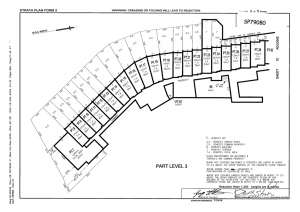
You may have heard of the following terms mentioned in your regular strata related dealings: Strata Schemes, Strata Plan and Strata Title.
You may even understand that somehow they are all related, but how exactly, that remains a bit of a mystery. In this article we will try and demystify this terminology for you.
Please note: this article does not reflect the NSW Strata Schemes Management Act 2015 which came into effect on 30 November 2016. It is based on the NSW Strata Schemes Management Act 1996. Please use this article for information only, and check with your strata manager to ensure you comply with the most up-to-date legislation and requirements.
What is Strata Title?
Strata Title is a type of ownership structure established for multi-level apartment buildings and horizontal sub-divisions with shared, common areas. ‘Strata’ is another word for a multi-level building. Believe it or not but this ‘system’ was invented here in New South Wales, Australia and is now exported to the world. Countries such as New Zealand, Canada, South Africa, India, Dubai and Indonesia have all adopted the Australian system or a variation of it.
The NSW Conveyancing (Strata Titles) Act, 1961 came into force on 1 July 1961. A few weeks later the first Strata Plan in the world was registered in the suburb of Burwood, a block of 18 units named Lindsay Gardens. It would be the beginning of NSW strata living and has led to a thriving NSW strata community!
The innovation that Strata Title offered was that it enabled individuals or businesses to own a section of a property, or a ‘Lot’ and combined this with the shared ownership of Common Property. The day-to-day management is done through the Owners Corporation.
The Strata Title system gradually replaced the so-called ‘Company Title’ system where one holds a share in a company which owns the actual building you live in. These shareholders hold exclusive use of one of the units. The owners are so-called Tenants In Common, which is a form of co-ownership. Financial institutions were not keen to loan to buyers of Company Title units, and purchasers were typically charged higher interest rates as a consequence.
What is a Strata Title Scheme?
Quite simply a Strata Scheme is any building set up under the various Strata Schemes Acts and Regulations in NSW. This could be your typical multi-dwelling unit (MDU) or apartment complex but can also cover retirement villages, resorts and even caravan parks. Both the terms ‘Strata Title Scheme’ and ‘Strata Scheme’ are used interchangeably.
What is a Strata Plan?
Each parcel of Real Property land, i.e. land used for the purpose of residential or commercial property, on which a Strata Scheme building is built must be subdivided into a Strata Plan (SP). In other words, all Strata Schemes are represented by means of a Strata Plan.
Each NSW Strata Plan must be registered with the NSW Government’s department of Land & Property Information (LPI). In order for a SP to be registered a number of criteria must be met. The requirements are quite specific and details, so I have provided a summary below:
- Administration Sheets must be completed which summarise all administrative information, such as name and address to be used for servicing of notices, applicable by-laws, a schedule of unit entitlements, approvals and relevant certificates for the SP and to make it all official signatures and seals.
Before we continue, let me briefly explain the terms By-Laws and Unit Entitlements:
- By-Laws stipulate the ‘rules’ applicable to owners and tenants who live in the building and could cover anything from the keeping of pets, use of common property, parking and the installation of air-conditioning units. By-Laws will be covered in a future article, so what’s this space.
- The Schedule of Unit Entitlements breaks down for each unit, or ‘Lot’, what their ‘weighting’ is compared to other lots. Despite common believe that this is based on the floor space of a Lot, this is in fact based on the perceived “market value” of the Lots on the date of registration of the Strata Plan, as determined by the developer of the building. It reflects the relative value of one Lot compared to the other Lots in a building.
For example, a residential apartment building consists of 10 units. The units all have 2 bedrooms and identical floor plans. There are 2 penthouse apartments with spectacular views of the City and harbour. In this instance, the unit entitlements for these 2 penthouses could be “20” each, whereas the other units have “10” each. This brings the aggregate to 120 (8 x 10, plus 2 x 20). This means that the owners of the penthouses have a 20/120 = 16.67% share in the overall vote, whereas the other owners would have an 8.33% vote (10/120). It also means the penthouse owners pay a higher share of the strata levies and sinking fund payments.
It is also important to note that everything within the parcel of land which does not form part of a Lot is deemed to be Common Property.
- Plan Drawing Sheets must be provided and contain details on the exact geographical location of the building. It shows how the building sits in relation to the land parcel’s boundary. A floor plan must also be provided and is used to define the new strata lots.

- Encroachments, previously covered in a blog post (click here), must also be clearly defined. The council must be satisfied that the encroachment(s) does not endanger the public safety or interfere with neighbourhood amenities. There are a number of conditions that need to be met, but covering these goes beyond the scope of this article.
- Easements, which give somebody the right to use a section of land which they do not own, must also clearly be marked on the location and floor plan. Easements are typically used to gain access to a part of the parcel of land.
If you are keen to understand the details, I suggest you have a look at the website of the NSW Government Department of Land & Property Information. You can find them here.
Once a Strata Plan is registered a unique code will be allocated. This is the code you typically find on your Annual General Meeting (AGM) documentation or levy notices, for example ‘SP62199’.
What happens once a Strata Plan is registered?
Once the plan and administration sheets have been processed by the Department these will be placed on public record. From then onwards all common property sits with the Owners Corporation and a so-called Certificate of Title is issued for the common property and individual lots. Once a Strata Plan is registered, it effectively means that the Owners Corporation comes into existence!
Newly registered Strata Plans are typically owned by developers who will put the units on the market for sale, if they haven’t already sold them “off the plan”. There are specific rules & regulations guiding developers.
Premium Strata offers a tailor-made solution for developers and will assist them every step of the way in getting their property registered as a NSW Strata Plan. Premium Strata offers both excellent Strata Management and Building Management services. Call us today for an obligation free chat! We are happy to answer any questions you may have.
We hope you found this little guide useful. Please keep your eyes open for future posts, as we will continue to work towards making the somewhat complex world of strata management just that little bit easier to understand.